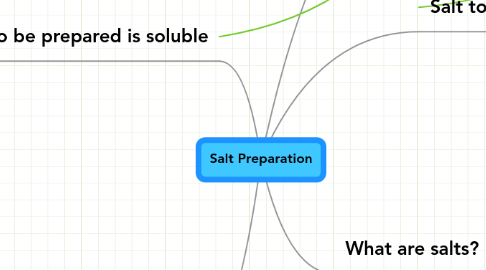
1. Salt to be prepared is soluble
1.1. Salt is a sodium, potassium or ammonium salt
1.1.1. Titration & Neutralision
1.1.1.1. Process
1.1.1.1.1. Place alkali in a burette and known amount of acid in a beaker
1.1.1.1.2. Add indicator to acid in beaker
1.1.1.1.3. Add acid to alkali until reaction is complete
1.1.1.1.4. Record the volume of alkali used
1.1.1.1.5. Repeat again, this time without the indicator
1.1.1.2. Starting Materials
1.1.1.2.1. An acid and an alkali
1.1.2. All such salts are soluble
1.1.2.1. Impossible to obtain a insoluble, solid reactant
1.2. Salt is otherwise
1.2.1. Process
1.2.1.1. Acid is added into beaker and warmed
1.2.1.1.1. Warmer acid reacts faster
1.2.1.1.2. Increased rate of effective collisions
1.2.1.2. Add solid reactant in excess, stirring it
1.2.1.2.1. Adding in excess ensures all acid has reacted
1.2.1.2.2. Stirring increases the rate of reaction
1.2.1.3. Filter mixture
1.2.1.3.1. Filtrate is salt solution
1.2.1.3.2. Residue is unreacted solid reactant
1.2.2. Starting materials
1.2.2.1. An acid
1.2.2.2. Solid insoluble reactant
1.2.2.2.1. Insoluble metal oxides
1.2.2.2.2. Metal carbonates
1.2.2.2.3. Metals
2. Objective
2.1. To obtain a pure, crystallised, hydrated sample of a salt
2.2. Steps taken
2.2.1. Obtaining a pure salt solution
2.2.2. Crystallising the solution
3. Salt to be prepared is not soluble
3.1. Precipitation
3.1.1. Starting Materials
3.1.1.1. A soluble salt containing the basic component
3.1.1.2. Another soluble salt containing the required acidic component
3.1.1.3. Alternatively, an acid can be used
3.1.2. Process
3.1.2.1. Mix the 2 solutions
3.1.2.2. Filter the product
3.1.2.2.1. The insoluble salt forms as a precipitate (the residue)
3.1.2.2.2. Liquid solution is called the supernate (the filtrate)
4. What are salts?
4.1. Ionic Compound (neutral)
4.1.1. Cation (Positively Charged Ions)
4.1.1.1. Examples are (for salts):
4.1.1.1.1. Na+ (sodium ion)
4.1.1.1.2. Mg2+ (magnesium ion)
4.1.1.1.3. K+ (potassium ion)
4.1.2. Anion (Negatively Charged Ions)
4.1.2.1. Examples are (for salts):
4.1.2.1.1. CH3COO- (ethanoate)
4.1.2.1.2. SO4 2- (sulphate)
4.1.2.1.3. NO3- (nitrate)
4.1.2.1.4. Cl-(chloride)
4.2. Formed when a metallic ion replaces one or more hydrogen ions in an acid
4.2.1. Examples are:
4.2.1.1. sulphates
4.2.1.1.1. formed from sulphuric acid (H2SO4)
4.2.1.2. chlorides
4.2.1.2.1. formed from hydrochloric acid (HCl)
4.2.1.3. nitrates
4.2.1.3.1. formed from nitric acid (HNO3)
4.2.1.4. carbonates
4.2.1.4.1. formed from carbonic acid (H2CO3)
4.2.1.5. ethanoates
4.2.1.5.1. formed from ethanoic/acetic acid (CH3COOH)
4.2.1.6. fluorides
4.2.1.6.1. formed from hydrofluoric acid (HF)
5. Obtain crystallised sample
5.1. Heat filtrate until solution is saturated and leave it to cool
5.1.1. Test for saturation by dipping cold, glass rod
5.1.1.1. Crystals will form if solution is saturated
5.1.2. Crystals will only form from cool solutions
5.2. Dry crystals by pressing them between sheets of filter paper
5.2.1. Heating to dryness will cause crystals to lose water of crystallisation
5.2.1.1. They will then become powders
5.2.1.2. E.g. copper sulphate
5.2.1.2.1. Anhydrous copper sulphate is a white powder
5.2.1.2.2. Hydrated copper suphate is in the form of blue crystals
